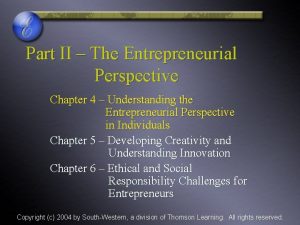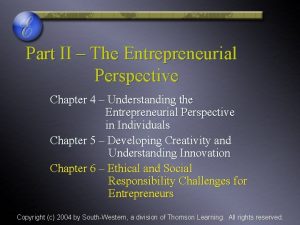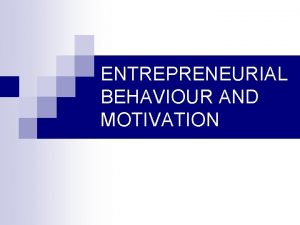Part 2 The Entrepreneurial Perspective CHAPTER 6 Entrepreneurial



























- Slides: 27

Part 2 The Entrepreneurial Perspective CHAPTER 6 Entrepreneurial Ethics Entrepreneurship Power. Point Presentation by Charlie Cook The University of West Alabama © 2007 Thomson/South-Western. All rights reserved. theory | process | practice Seventh edition Donald F. Kuratko • Richard M. Hodgetts

Chapter Objectives Studying this chapter should provide you with the entrepreneurial knowledge needed: 1. To discuss the importance of ethics for entrepreneurs 2. To define the term ethics 3. To study ethics in a conceptual framework for a dynamic environment 4. To review the constant dilemma of law versus ethics 5. To examine the role of ethics in the free enterprise system 6. To present strategies for establishing ethical responsibility © 2007 Thomson/South-Western. All rights reserved. 6– 2 2

Chapter Objectives (cont’d) Studying this chapter should provide you with the entrepreneurial knowledge needed: 7. To introduce the challenge of social responsibility 8. To emphasize the importance of entrepreneurs taking a position of ethical leadership © 2007 Thomson/South-Western. All rights reserved. 6– 3 3

Defining Ethics A set of principles prescribing a behavioral code that explains what is good and right or bad and wrong; ethics may outline moral duty and obligations. Ø Provide the basic rules or parameters for conducting any activity in an “acceptable” manner. Ø Reasons for Ethical Conflicts The many interests that confront business enterprises both inside and outside the organization Ø Changes in values, mores, and societal norms Ø © 2007 Thomson/South-Western. All rights reserved. 4

Figure 6. 1 Classifying Decisions Using a Conceptual Framework Source: Verne E. Henderson, “The Ethical Side of Enterprise, ” Sloan Management Review (spring 1982): 42. © 2007 Thomson/South-Western. All rights reserved. 5

Ethics and Laws Managerial Rationalizations Ø Justifications in defense of unethical acts are believing that an activity: • Is not “really” illegal or immoral. • Is in the individual’s or the corporation’s best interest. • Will never be found out. • That helps the company will be condoned by the company. © 2007 Thomson/South-Western. All rights reserved. 6

Table 6. 1 Types of Morally Questionable Acts Source: James A. Waters and Frederick Bird, “Attending to Ethics in Management, ” Journal of Business Ethics 5 (1989): 494. © 2007 Thomson/South-Western. All rights reserved. 7

The Matter of Morality Ethical conduct may reach beyond the limits of the law. The requirements of law may overlap at times but do not duplicate the moral standards of society. Ø Legal requirements tend to be negative (forbidding acts), whereas morality tends to be positive (encouraging acts). Ø Legal requirements usually lag behind the acceptable moral standards of society. Ø Inherent problems arise when people believe laws represent morality. Ø © 2007 Thomson/South-Western. All rights reserved. 8

Figure 6. 2 Overlap Between Moral Standards and Legal Requirements © 2007 Thomson/South-Western. All rights reserved. 9

Table 6. 2 Major Problems Regarding Laws Reflecting Ethical Standards 1. The moral standards of members of society may be based on a lack of information relative to issues of corporate conduct. 2. The moral standards of members of society may be diluted by the formation of small groups. 3. The moral standards of members of society may be misrepresented in the consensus of large organizations. 4. The moral standards of members of society may be misrepresented in the formulation of the laws. 5. The legal requirements formed through the political process are often incomplete or imprecise and have to be supplemented by judicial court decisions or administrative agency actions. Source: Reproduced with permission from La. Rue T. Hosmer, The Ethics of Management, 2 nd ed. (Homewood, IL: Richard D. Irwin, 1991), 91– 92. © 2007 Thomson/South-Western. All rights reserved. 10

Economic Trade-Offs Innovation, risk taking, and venture creation are the backbone of the free enterprise system which fosters individualism and competition. Ø We cannot blame single individuals for the ethical problems of free enterprise. Ø Rather, we must understand the total, systematic impact that free enterprise has on the common good. © 2007 Thomson/South-Western. All rights reserved. 11

Reasons for Unethical Behavior Greed Distinctions between activities at work and activities at home A lack of a foundation in ethics Survival (bottom-line thinking) Reliance on other social institutions to convey and reinforce ethics. © 2007 Thomson/South-Western. All rights reserved. 12

Establishing a Strategy for Ethical Responsibility Ethical Practices and Codes of Conduct A code of conduct is a statement of ethical practices or guidelines to which an enterprise adheres. Ø Codes of conduct are becoming more prevalent in industry. Ø Recent codes are proving to be: Ø • More meaningful in terms of external legal and social development • More comprehensive in terms of their coverage, and easier to implement in terms of the administrative procedures used to enforce them. © 2007 Thomson/South-Western. All rights reserved. 13

Approaches to Managerial Ethics Immoral Management Amoral Management • Managerial decisions, actions and behavior imply a positive and active oppositions to what is moral (ethical). • Management is neither moral or immoral, but decisions lie outside the sphere to which moral judgments apply. • Decisions are discordant with accepted ethical principles. • Managerial activity is outside or beyond the moral order of a particular code. • An active negation of what is moral is implied. • A lack of ethical perception and moral awareness may be implied. Moral Management • Managerial activity conforms to a standard of ethical, or right, behavior. • Managers conform to accepted professional standards of conduct. • Ethical leadership is commonplace on the part of management. Source: Archie B. Carroll, “In Search of the Moral Manager, ” Business Horizons (March/April 1987): 12. Copyright © 1987 by the Foundation for the School of Business at Indiana University. Reprinted by permission. © 2007 Thomson/South-Western. All rights reserved. 14

A Holistic Approach Principle 1: Hire the right people Principle 2: Set standards more than rules Principle 3: Don’t let yourself get isolated Principle 4: The most important principle is to let your ethical example at all times be absolutely impeccable © 2007 Thomson/South-Western. All rights reserved. 15

Shaping an Ethical Strategy The entrepreneur’s guiding values and commitments must make sense and be clearly communicated. Entrepreneurs must be personally committed, credible, and willing to take action on the values they espouse. The espoused values must be integrated into the normal channels of the organization’s critical activities. The venture’s systems and structures must support and reinforce its values. Employees throughout the company must have the decision-making skills, knowledge, and competencies needed to make ethically sound decisions every day. SOURCE: Adapted from Lynn Sharp Paine, “Managing for Organizational Integrity, ” Harvard Business Review (March/April 1994): 106– 117. © 2007 Thomson/South-Western. All rights reserved. 16

Ethical Responsibility Ethical Consciousness Ethical Process and Structure Ethical Responsibility Institutionalization © 2007 Thomson/South-Western. All rights reserved. 17

Figure 6. 3 Four Main Themes of Ethical Dilemmas for Entrepreneurs Source: Shailendra Vyakarnam, Andy Bailey, Andrew Myers, and Donna Burnett, “Towards an Understanding of Ethical Behavior in Small Firms, ” Journal of Business Ethics 16(15) (1997): 1625 -1636. © 2007 Thomson/South-Western. All rights reserved. 18

Ethics and Business Decisions Complexity of Ethical Decisions: Ø Ethical decisions have extended consequences Ø Business decisions involving ethical questions have multiple alternatives. Ø Ethical business often have mixed outcomes. Ø Most business decisions have uncertain ethical consequences. Ø Most ethical business decisions have personal implications. © 2007 Thomson/South-Western. All rights reserved. 19

The Social Responsibility Challenge Social Obligation Ø Firms that simply react to social issues through obedience to the laws. Social Responsibility Ø Firm that respond more actively to social issues; accepting responsibility for various programs. Social Responsiveness Ø Firms that are highly proactive and are even willing to be evaluated by the public for various activities. © 2007 Thomson/South-Western. All rights reserved. 20

Table 6. 4 What is the Nature of Social Responsibility? Environment Energy Fair Business Practices Human Resources Community Involvement Products Source: Richard M. Hodgetts and Donald F. Kuratko, Management, 3 rd ed. (San Diego: Harcourt Brace Jovanovich, 1991), 670. © 2007 Thomson/South-Western. All rights reserved. 21

Table 6. 5 Classifying Corporate Social Behavior Source: Excerpted from S. Prakash Sethi, “A Conceptual Framework for Environmental Analysis of Social Issues and Evaluation of Business Response Patterns, ” Academy of Management Journal (January 1979): 68. © 2007 Thomson/South-Western. All rights reserved. 22

Figure 6. 4 Ethical Considerations in Corporate Entrepreneurship Source: Justin G. Longenecker, Joseph A. Mc. Kinney, and Carlos W. Moore, “Ethics in Small Business, ” Journal of Small Business Management (January 1989): 30. © 2007 Thomson/South-Western. All rights reserved. 23

Ethical Leadership by Entrepreneurs The Opportunity for Ethical Leadership by Entrepreneurs An owner has the unique opportunity to display honesty, integrity, and ethics in all key decisions. Ø The owner’s actions serve as a model for other employees to follow. Ø An owner’s value system is a critical component of the ethical considerations that surround a business decision Ø © 2007 Thomson/South-Western. All rights reserved. 24

Table 6. 6 Issues Viewed By Small-Business Owners Source: Justin G. Longenecker, Joseph A. Mc. Kinney, and Carlos W. Moore, “Ethics in Small Business, ” Journal of Small Business Management (January 1989): 30. © 2007 Thomson/South-Western. All rights reserved. 25

The Ethics of Caring Ø A feminine alternative to the more traditional and masculine ethics that are based on rules and regulations. Following laws may not lead to building as strong of relationships as one could. Entrepreneurs must realize that their personal integrity and ethical example will be the key to their employees’ ethical performance. © 2007 Thomson/South-Western. All rights reserved. 26

Key Terms and Concepts amoral management code of conduct ecovision ethics environmental awareness immoral management nonrole © 2007 Thomson/South-Western. All rights reserved. rationalizations role assertion role distortion role failure social obligation social responsibility social responsiveness 27
 The entrepreneurial perspective
The entrepreneurial perspective The entrepreneurial perspective
The entrepreneurial perspective One point perspective staircase
One point perspective staircase Silo perspective vs business process perspective
Silo perspective vs business process perspective The pathways to new ventures for entrepreneurs
The pathways to new ventures for entrepreneurs Chapter 33 entrepreneurial concepts answers
Chapter 33 entrepreneurial concepts answers Hát kết hợp bộ gõ cơ thể
Hát kết hợp bộ gõ cơ thể Bổ thể
Bổ thể Tỉ lệ cơ thể trẻ em
Tỉ lệ cơ thể trẻ em Gấu đi như thế nào
Gấu đi như thế nào Glasgow thang điểm
Glasgow thang điểm Hát lên người ơi alleluia
Hát lên người ơi alleluia Các môn thể thao bắt đầu bằng tiếng nhảy
Các môn thể thao bắt đầu bằng tiếng nhảy Thế nào là hệ số cao nhất
Thế nào là hệ số cao nhất Các châu lục và đại dương trên thế giới
Các châu lục và đại dương trên thế giới Công của trọng lực
Công của trọng lực Trời xanh đây là của chúng ta thể thơ
Trời xanh đây là của chúng ta thể thơ Cách giải mật thư tọa độ
Cách giải mật thư tọa độ Làm thế nào để 102-1=99
Làm thế nào để 102-1=99 độ dài liên kết
độ dài liên kết Các châu lục và đại dương trên thế giới
Các châu lục và đại dương trên thế giới Thơ thất ngôn tứ tuyệt đường luật
Thơ thất ngôn tứ tuyệt đường luật Quá trình desamine hóa có thể tạo ra
Quá trình desamine hóa có thể tạo ra Một số thể thơ truyền thống
Một số thể thơ truyền thống Cái miệng nó xinh thế
Cái miệng nó xinh thế Vẽ hình chiếu vuông góc của vật thể sau
Vẽ hình chiếu vuông góc của vật thể sau Biện pháp chống mỏi cơ
Biện pháp chống mỏi cơ
















































